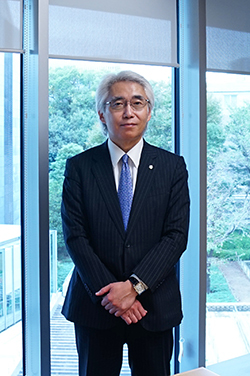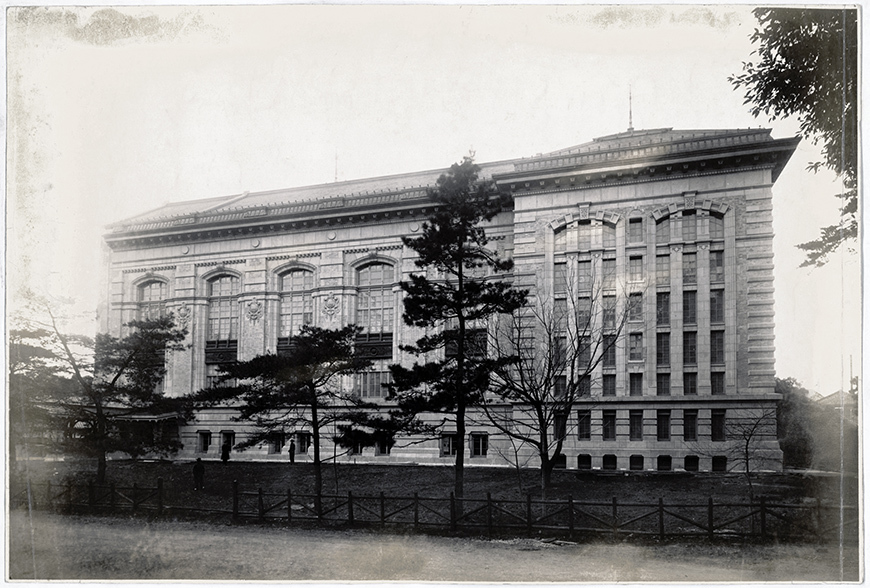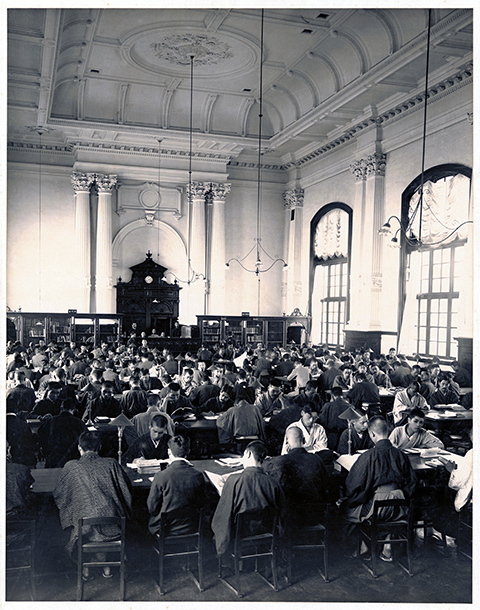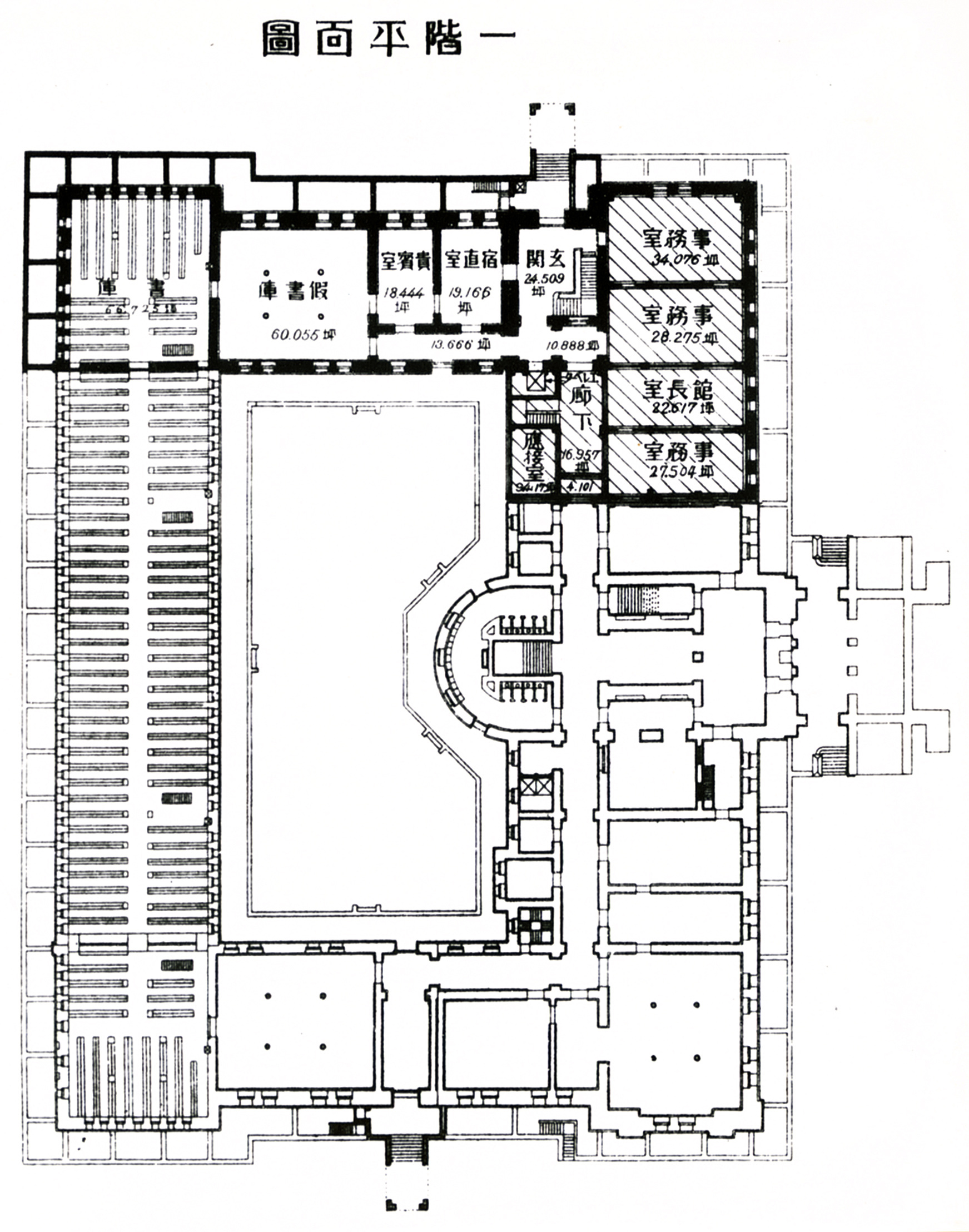
Ken-ichi Terakura, a chief librarian of the International Library of Children's Literature
We talked with Ken-ichi Terakura, a chief librarian of the International Library of Children's Literature. (Interview: October 2018)
Foundation of the International Library of Children's Literature
Q: Could you talk about circumstances in which the International Library of Children's Literature was founded?
Terakura: This library was originally built as the Imperial Library in 1906. It is the brick building facing the Tokyo National Museum. The building is the Renaissance style brick building in the Meiji Period, and has a log of aesthetic charms.
Although the Imperial Library was temporarily renamed "Kokuritsu Toshokan," or national library, about one year later, it was integrated with the National Diet Library as one organization of it. Then, it provided services under the name of "Shibu Ueno Library" of the National Diet Library for a long time. The library functioned as a facility to mainly collect and provide doctoral dissertations at that time. When it was integrated with the National Diet Library, there was a plan to transfer the control of it to Tokyo Metropolis. However, Tokyo also founded its own library, so they decided that there was no need to transfer it in 1990s. They discussed how to handle this building. It was just the time when children's tendency to read books less came to an issue. There were also large social concerns about the issue, and many members of the Diet as well as people involved in children's books and education had a sense of crisis. There were increasing calls for turning it into an organization to support an activity of promoting book reading as a national children's library.
People from every field supported the activity, more than 200 members of the Diet formed a suprapartisan league, and the National Diet Library Law by which the International Library of Children's Literature was founded was revised in the Diet. As a result, the International Library of Children's Literature was newly opened in 2000. The new building (the arch-shaped building) was also completed in 2015, and continues to exist.
Scenes of the Ueno area when the library was founded
Q: How were the situations of Ueno Park and the Ueno area when the Imperial Library was founded?
The former Tokyo Music School (the present Music Department, Tokyo University of the Arts) was established in 1887 before the foundation of the former Imperial Library. The Education Museum was already built in 1880 within the grounds on which the former Tokyo Music School would be constructed. The museum was also a red-brick building. The museum building still exists, and is now used as lounges of Tokyo University of the Arts.
Then, Sogakudo of the former Tokyo Music School was built in 1890, and such facilities gradually increased. The former Imperial Library was built in this place in 1906, and a building with a bronze roof, called Hyokeikan, was constructed in the grounds of the Tokyo National Museum in 1908 (Note: Although Hyokeikan was completed in 1908, it opened in 1909). It was built to celebrate the marriage of the Taisho Emperor when he was the Crown Prince. It was designed by Tokuma Katayama, a famous court architect.
In 1928, Kuroda Memorial Hall, which is now an annex of the Tokyo National Museum, was built next to the Imperial Library. In 1926, shortly before the foundation of Kuroda Memorial Hall, Tokyo Prefectural Museum (the present Tokyo Metropolitan Art Museum) was built. When the Showa Period began, this area was developed, and the former Hakubutsukan Dobutsuen Station of Keisei Electric Railway, which was designated as a historic building in Tokyo in 2018, was also built. Then, in 1937, the main hall of the present Tokyo National Museum was built (Note: Although it was completed in 1937, it opened in 1938). Cultural and educational facilities were built one after another in this area from the late Meiji to early Showa Periods. I think scenes in this area in the early Showa Period were already fairly similar to those in the present. (continued in the lower column)
Former Imperial Library at that time when it was founded (Owned by the International Library of Children's Literature)

Standard reading room (the present "Book Museum" on the third floor of the brick building: Owned by the International Library of Children's Literature)

Relics and plans at that time when the library was founded
Q: What kind of building was the former Imperial Library when it was built? Are there places and relics that have been preserved as they were?
Although the former Imperial Library's building called the brick building was repaired several times, some relics have been preserved. The chandelier hung from the ceiling of the large stair leading from the first to the third floors of the brick building is more than 100-year-old, and just as it was at that time. The handrail of the stair and the nearby zelkova door are also as they were at that time. (continued in the right column)
Moreover, there is the monument of Yakumo Koizumi in front of the brick building. It was built in 1935. I heard that a son of Bansui Doi, a poet, greatly adored Yakumo Koizumi. Although the son died young, he told this father before his death that he wanted to build a monument in honor of Koizumi. Bansui Doi had a close relationship with the then chief librarian of the former Imperial Library, so the monument was built in this place.
Let me add a few more words on the former Imperial Library. Actually, it was planned to build about four times larger building. They planned to build a very large building with a courtyard inside, of which one side is this brick building. However, it was the time when the Russo-Japanese War was just over, and financial conditions were tight. So the budget was cut, and they had to settle for about a quarter the size. Only one side of the initially planned building was realized.
Although the innermost hall in the brick building was slightly enlarged in the Showa Period, further enlargement was not conducted, and the initial grand vision did not become a reality.
Q: Did they plan to construct a building around a courtyard?
It seems that they planned to build a quadrangular building with a courtyard inside, of which one side is this brick building. The present part of the building with the entrance facing the road was supposed to be the east side. In the initial plan, a facade was supposed to be on the south side.
Plan of the former Imperial Library when it was initially planned (Owned by the International Library of Children's Literature)

Q: Under what circumstances was the former Imperial Library founded?
The Imperial Library was founded in 1906 under the following circumstances. Inagi Tanaka, a Japanese library science scholar who was active in the field of the library administration, was the first chairman of "Nihon Bunko Kyokai" (the present Japan Library Association) at that time, and became a chief librarian of "Tokyo Toshokan," or Tokyo library (later, he also became the first chief librarian of the former Imperial Library). He advocated that Japan had to have a great national library like those in Western countries because Japan also took its place among the ranks of advanced countries. So a bill regarding the foundation of the Imperial Library was passed in the Imperial Diet, and, as a result, the regulations for the Imperial Library were established in 1897. That is the act of foundation. It was an imperial ordinance to build the library.
Q: The former Imperial Library is the elegant, Western style building. Did they build it with reference to something?
Although Masamichi Kuru, an architect who was responsible for construction of government buildings and a technical officer at the Ministry of Education at that time, mainly developed the concept for building the library, his subordinate, Hideo Masamichi, conducted an overseas inspection, and the Imperial Library was designed with reference to the Library of Congress, a national library in the United States, on which the Imperial Library was modeled, as well as the Boston Public Library and the Newberry Library in Chicago.
Q: What kind of role did the Imperial Library have at that time?
It goes without saying that the library was used by the public. Moreover, it collected and stored national materials as a national library. It also provided special services for researchers, and those researchers used a special reading room.
Q: I heard that a plate of the Imperial Library has been preserved.
Although the plate is now let out to the National Diet Library for the exhibition (70-anniversary Commemorative Exhibition: A Treasure Box of Books) (at the time of this interview), it is usually exhibited in a hall on the third floor.
Q: Was the role changed when it was integrated with the National Diet Library?
The National Diet Library is a large organization, and has a variety of roles, including investigation and research to assist activities of the Diet and comprehensive collections of domestic publications through a legal deposit system. A division of the former Imperial Library became Shibu Ueno Library, had a role to provide materials, including doctoral dissertations, for a long time. The library became the International Library of Children's Literature in 2000, so all materials for children, which were stored in the National Diet Library, were moved to the International Library of Children's Literature, and the stored doctoral dissertations were transferred to a place called Kansai-kan. By the way, when we say materials for children, they refer to materials for youth and children aged 18 or younger.

Ken-ichi Terakura, a chief librarian of the International Library of Children's Literature














